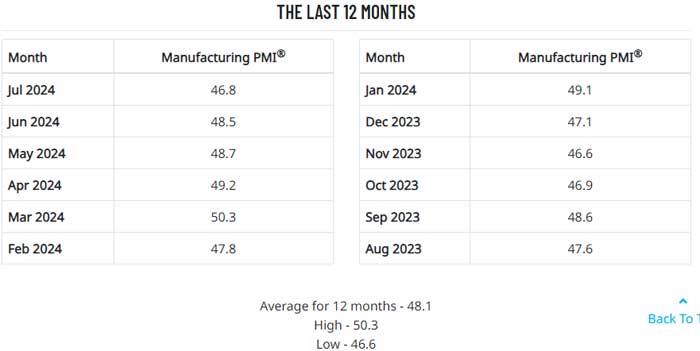The US Purchasing Managers Index (PMI) for July was released Thursday by the Institute for Supply Management (ISM), and came at a level of 46.8, again below the key 50 mark that separates US manufacturing expansion from contraction.
The US PMI had previously been in contraction territory for 16 straight months until it poked its head into expansion in March, but has fallen back to contraction now in each of the last three months.
The overall economy continued in expansion for the 51st month after one month of contraction in April 2020. The PMI tracks closely but not exactly with the overall US economy.
A Manufacturing PMI above 42.5, over a period of time, generally indicates an expansion of the overall economy, according to ISM.
The other PMI numbers we track were also mostly negative.
That starts with the New Order Index, which remained in contraction territory, registering a score of 47.4, 1.9 percentage points lower than recorded in June, in a negative sign for future US manufacturing activity.
The July score of the Production Index was 45.9, 2.6 percentage points lower than June’s figure of 48.5, as manufacturing output once was in contraction status.
The Price Index registered 52.9, up a bit from the June score of 52.1. That means most companies saw a rise in the cost of components, materials and other inputs (below 50 = falling prices), a little more strongly versus the previous month.
The Backlog of Orders Index was at a low level of 41.7 for the second consecutive month. That means the order book of most companies is shrinking, with the index level still well below the 50 mark.
The Supplier Deliveries Index remained in “slower” territory, at 52.6.
Supplier Deliveries is the only ISM index that is inversed, with a reading of above 50 indicating slower deliveries, which is typical as the economy improves and customer demand increases - or the reverse.
The Inventories Index came in at a score of 44.5, down 0.9 percentage point compared to June’s reading of 45.4, with the score below 50 indicating inventory levels at companies are again decreasing.
Said Timothy Fiore, Chair of the Institute for Supply Management Manufacturing Business Survey Committee: “Demand remains subdued, as companies show an unwillingness to invest in capital and inventory due to current federal monetary policy and other conditions.”
He added that “Production execution was down compared to June, likely adding to revenue declines, putting additional pressure on profitability. Suppliers continue to have capacity, with lead times improving and shortages not as severe.”
(See More Below)
|
CATEGORY SPONSOR: SOFTEON |
|
|
| |
| |
|
|
As always, the ISM report provides a graphic of the PMI scores the last 12 months, which as can be seen indicates the measure has been below the key 50 for the past year and actually since November 2022, with the exception of March 2024. It is now averaging just 48.1 over the past year.
US PMI Last 12 Months

Source: ISM
Of the 18 sectors tracked by ISM, just five reported growth in June. They are, in order: Printing & Related Support Activities; Petroleum & Coal Products; Miscellaneous Manufacturing; Furniture & Related Products; and Nonmetallic Mineral Products.
As always, there were some interesting comments from PMI survey respondents.
“Business is relatively flat - the same volume, but smaller orders.” said one manager in the chemicals sector.
“It seems that the economy is slowing down significantly. The number of sales calls received from new suppliers is increasing significantly. Our own order backlog is also diminishing,” added a respondent in the machinery industry.
Finally, a manager in the food and beverage observed that “Even though we are used to a seasonal reduction in business over the summer, consumer behavior is changing more than normal. Sales are lighter, and customer orders are coming in under forecasts. It seems consumers are starting to pull back on spending.”
|